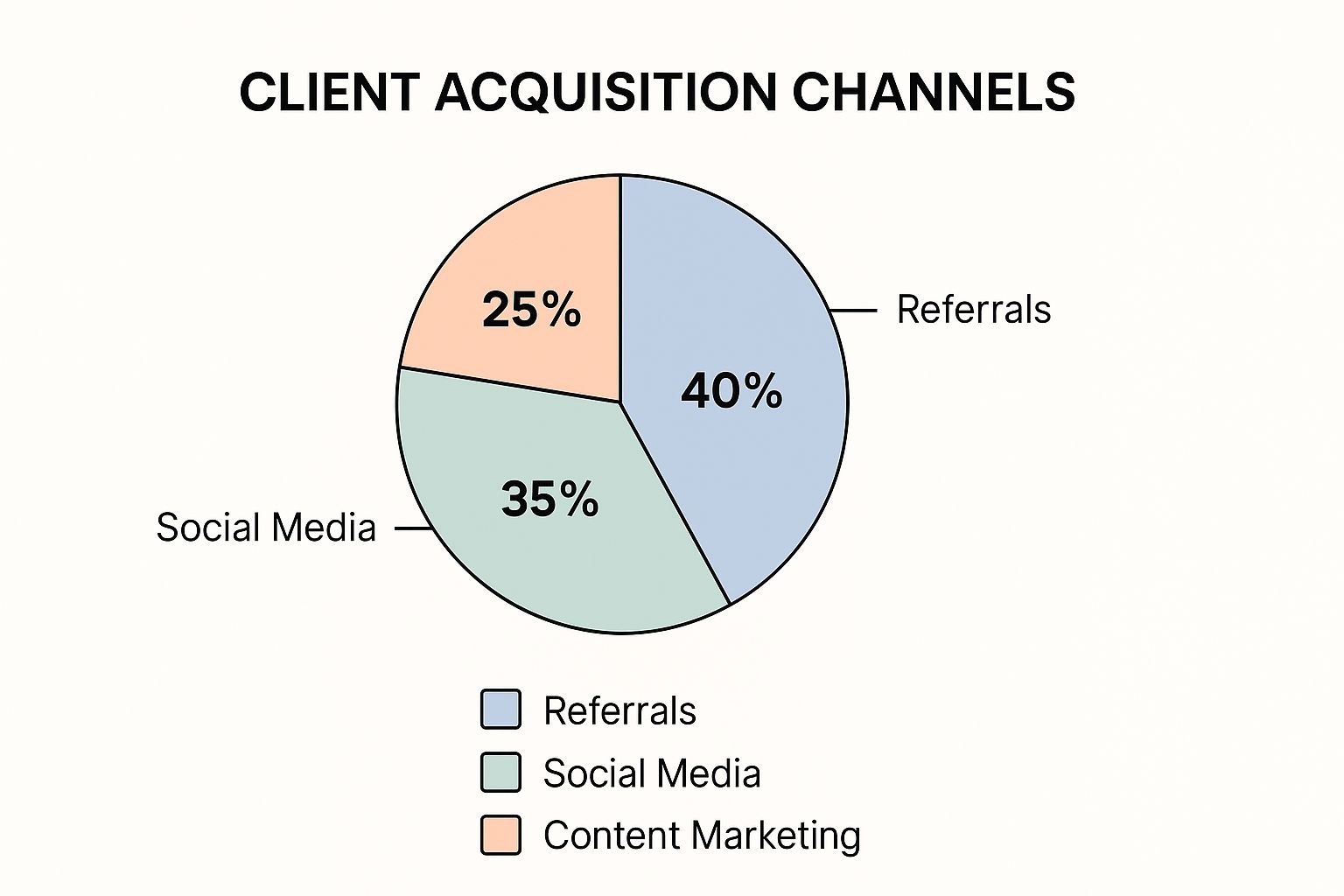The Real Economics Behind Client Attraction
Attracting new clients fuels business growth. But focusing only on acquisition, without considering the costs, can lead to unsustainable spending. This section explores the financial realities of gaining new clients versus keeping the ones you already have, and how to find the right balance between the two.
Calculating Your Client Acquisition Cost
Understanding your Client Acquisition Cost (CAC) is essential. It's calculated by dividing your total marketing and sales expenses by the number of new clients acquired. For example, if you spend $5,000 on marketing and gain 50 new clients, your CAC is $100. This metric reveals how profitable your marketing is and helps you identify areas for improvement.
The Power of Client Retention
While attracting new clients is important, nurturing your existing client relationships is even more vital. Studies show acquiring a new customer can cost 5 to 25 times more than keeping an existing one. What's more, acquisition costs have increased dramatically – by 222% in recent years! This emphasizes the importance of client retention strategies. Learn more about impactful customer acquisition statistics. It's time to shift from an acquisition-only mindset to one that values and prioritizes building lasting client relationships.
Balancing Acquisition and Retention
Let's take a look at the following table to compare new client acquisition and client retention:
New Client Acquisition vs. Client Retention
Comparison of costs, conversion rates, and revenue contribution between new and existing clients
| Metric | New Clients | Existing Clients |
|---|---|---|
| Acquisition Cost | High (e.g., $100 per client) | Low (e.g., $20 per client) |
| Conversion Rate | Typically Lower (e.g., 2-5%) | Typically Higher (e.g., 60-70%) |
| Revenue Contribution | Grows over time with repeat purchases | Contributes consistently through repeat business and potential upsells/cross-sells |
This table emphasizes the higher costs associated with acquiring new clients, while highlighting the higher conversion rates and consistent revenue stream generated by loyal, existing clients. This clearly illustrates the potential for a strong return on investment when you prioritize client retention.
The infographic below visualizes client acquisition channels for a hypothetical business, showing the relative impact of referrals, social media, and content marketing.

As the infographic shows, referrals are a powerful driver of new client acquisition, emphasizing the impact of strong existing relationships. While social media and content marketing have their place, building a robust referral network can be both highly effective and cost-efficient.
Strategies for Sustainable Client Growth
So, how can you balance acquisition and retention for sustainable growth? Here are some key strategies:
-
Exceptional Customer Service: Exceeding expectations and fostering loyalty turns customer service into a powerful client magnet.
-
Targeted Marketing: Focus your marketing efforts on reaching the ideal audience, avoiding wasted spend on broad, generic campaigns.
-
Referral Programs: Reward existing clients for bringing in new business, creating a win-win and leveraging the power of word-of-mouth.
-
Value-Added Content: Educate and engage your target audience with high-quality content, establishing yourself as an authority and attracting potential clients naturally.
-
Client Appreciation Initiatives: Show your appreciation with exclusive offers or personalized communication, strengthening relationships and encouraging repeat business.
By implementing these strategies, you can optimize your spending, build stronger client relationships, and achieve lasting growth. This reduces your reliance on expensive acquisition campaigns. It's about building a loyal client base that contributes to your long-term success.
Building a Brand That Naturally Attracts Your Ideal Clients

A strong brand is more than just a memorable logo. It tells a compelling story that truly resonates with your target audience. It's about expressing your unique value in a way that connects with potential clients, positioning you as the answer to their needs. This involves understanding your ideal client's challenges and speaking directly to their concerns, nurturing trust and highlighting your expertise.
Defining Your Unique Value Proposition
Your unique value proposition sets you apart. It's the compelling reason clients choose you over everyone else. It's not simply what you do, but how you do it and the distinct benefits clients receive. Consider Henri Den, a seasoned branding expert with nonprofit experience. This background gives him unique insights into purpose-driven branding. His personal journey connects with those seeking deeper meaning in their work, a significant differentiator in a profit-focused world.
Creating a Consistent Brand Voice
Consistency is fundamental for brand recognition. This means maintaining a consistent tone and style across all platforms. Ask yourself, is your brand playful and energetic, or thoughtful and introspective? This consistency builds familiarity and trust with potential clients.
Furthermore, ensure your brand voice is reflected in every communication, from your website and social media to emails and presentations. This reinforces your message and strengthens your unique value proposition.
Content as a Client Magnet
Creating a content ecosystem that offers real value to your target audience is crucial for organic client attraction. This could include blog posts, videos, podcasts, or social media updates. Focus on addressing client pain points and offering practical solutions.
For instance, a designer could share blog posts with simple branding tips, as highlighted in this helpful article about blog post ideas for designers. This demonstrates expertise and attracts potential clients seeking guidance. Further exploration can be found here: How to master…. By consistently delivering valuable content, you become a trusted authority, the go-to choice when clients are ready to invest. Attracting clients isn't just about visibility; it's about building authentic connections.
Building Trust and Authority
Demonstrating expertise and building trust are vital for attracting clients. Sharing client testimonials and case studies is highly effective. This social proof shows potential clients the positive impact of your services and builds confidence in your abilities.
Actively engaging with your audience on social media and online platforms is another powerful strategy. Responding to comments and questions shows your dedication to client satisfaction and fosters a sense of community.
Transforming Customer Service Into Client Magnetism
Exceptional customer service isn't just about keeping current clients happy. It's a powerful strategy for attracting new clients. It creates a ripple effect, transforming satisfied customers into enthusiastic advocates who attract new business. Let's explore how businesses across various sectors have turned outstanding service into their primary client acquisition channel.
Building Trust Through Communication
Clear, empathetic communication is the bedrock of excellent customer service. This means actively listening to client concerns, responding promptly and thoroughly, and using language that builds trust. Imagine a software company proactively reaching out to users experiencing difficulties, offering personalized support and guidance. This approach not only resolves the immediate issue, but also fosters a sense of connection and loyalty.
Exceeding Expectations With Problem Resolution
Effective problem resolution goes beyond simply fixing issues. It's about exceeding client expectations. This involves empowering customer service representatives to take ownership of problems, offering proactive solutions, and following up to ensure complete satisfaction. Consider implementing systems for gathering client feedback on resolved issues, allowing for continuous improvement and demonstrating a commitment to excellence.
Showcasing Service Excellence
To attract your ideal clients, consider showcasing your past successes. A well-designed portfolio, such as a stunning portfolio website, can be a powerful tool. While exceptional service speaks for itself, strategically showcasing it amplifies its impact on client acquisition. This could involve featuring client testimonials on your website, sharing positive customer service stories on social media, or highlighting service-related awards and recognitions. These actions demonstrate your commitment to client satisfaction and build credibility with potential clients.
Turning Service Failures Into Opportunities
Even with the best intentions, service failures are inevitable. However, these moments can be transformed into opportunities to strengthen your reputation and attract new clients. Acknowledge the failure, take responsibility, offer sincere apologies, and implement measures to prevent recurrence. The key is demonstrating genuine empathy and a commitment to making things right, turning a negative experience into a positive one.
The impact of customer service quality on client attraction and retention is significant. Consumer behavior is strongly influenced by their experiences. Statistics reveal that more than 50% of consumers will switch to a competitor after just one poor service interaction, and 73% will switch after multiple negative experiences. Find more detailed statistics here. This underscores the importance of investing in excellent customer support.
Creating a Culture of Client-Centric Service
Transforming customer service into a client acquisition engine requires creating a culture of client-centricity throughout your entire organization. This means empowering employees to prioritize client needs, fostering a sense of ownership and accountability, and rewarding exceptional service. By embedding client-centric values into your company's DNA, you create a powerful magnet that attracts and retains clients, driving sustainable growth and strengthening your brand reputation. This positions you as a leader in your industry.
Creating Client Attraction Funnels That Actually Convert

Attracting clients isn't about throwing marketing tactics at the wall and seeing what sticks. It's about building a system. Imagine a funnel, carefully guiding potential clients from their first encounter with your brand all the way to becoming loyal advocates. This is the power of a client attraction funnel, a system designed to convert prospects into paying clients. It starts with understanding the client journey and optimizing each stage for maximum impact.
Identifying Bottlenecks in Your Funnel
Just like a leaky bucket can't hold water, a leaky funnel loses valuable prospects. Identifying those leaks is the first step to patching them up. This means carefully analyzing each stage of your funnel, from the initial point of contact to the final purchase decision. Where are prospects dropping off? Are they leaving after visiting your landing page? Are they unsubscribing from your email list before making a purchase? Pinpointing these bottlenecks is crucial for optimizing your funnel's performance.
Crafting Compelling Lead Magnets
A lead magnet is a valuable offer you provide to prospects in exchange for their contact information. Think of it as a friendly handshake and an invitation to learn more. This could be a free ebook, a helpful checklist, an insightful webinar, or a practical template. The key is to offer something genuinely helpful that addresses a specific client need. A well-crafted lead magnet attracts the right clients and builds a relationship based on value.
Designing High-Converting Landing Pages
Your landing page is the destination for prospects who click on your offer. It's the virtual storefront where first impressions matter. It needs to be designed with one goal in mind: converting visitors into leads. This means a clear call to action, concise copy that highlights the benefits of your offer, and a user-friendly design. A well-optimized landing page is essential for capturing leads and moving them further down the funnel. Check out our guide on How to master… for more details on website optimization.
Nurturing Relationships With Persuasive Email Sequences
Once you have a prospect's email address, the real relationship building begins. Nurture that connection with a thoughtfully crafted email sequence. This involves sending a series of emails that provide valuable content, build trust, and ultimately lead to a sales offer. Personalization is key. Each email should be relevant to the prospect’s needs and interests, gently guiding them closer to becoming a client.
Tracking Your Progress With Actionable Metrics
How do you know if your funnel is working? By setting up a tracking system that provides valuable insights into its effectiveness. This involves tracking key metrics like conversion rates, click-through rates, and open rates. This data tells you what’s working and what needs adjustment, allowing you to refine your strategy for continuous improvement. This goes beyond vanity metrics and focuses on data that drives real business results. For example, instead of just tracking website visits, track how many visitors convert into leads and then into paying clients, giving you a clear measure of your marketing ROI.
Implementing Frameworks for Continuous Improvement
Building a successful client attraction funnel is not a one-time project; it's an ongoing process. Create systems for continuous improvement. This involves regularly reviewing your funnel's performance, experimenting with different approaches, and implementing changes based on data-driven insights. This iterative process of testing, measuring, and refining ensures your client attraction funnel remains effective and continues to deliver results. This might involve A/B testing different landing page designs or trying out different lead magnets to see what resonates best with your audience.
By implementing these strategies, you can create a client attraction funnel that consistently brings in new business and fuels your long-term success. It's not just about attracting any clients, but about attracting the right clients – those who are a good fit for your business and truly value your services.
Leveraging Client Relationships for Exponential Growth
Your existing clients are a goldmine of opportunity, a wellspring of potential growth. They already know and trust your brand, making them powerful advocates. This section explores how businesses are transforming these valuable relationships into engines for exponential growth. We'll delve into referral programs, collaborative content, and authentic advocacy initiatives that foster growth organically, without feeling forced or transactional.
The Power of Referral Programs
Referral programs can be incredibly effective, but only when they resonate with genuine value. Forget simple discounts. Instead, craft incentives that truly speak to your clients’ needs. Consider offering exclusive access to new resources, personalized consultations, or even opportunities for co-creating content. This cultivates a win-win scenario where both the referrer and the referred client feel appreciated and valued.
Collaborative Content: A Win-Win Approach
Creating collaborative content with your clients offers mutual benefits. Co-authoring blog posts, showcasing client success stories, or hosting joint webinars strengthens your relationship while simultaneously providing invaluable social proof for potential clients. Think of it as a partnership, a platform where you celebrate client achievements and empower them to share their expertise.
Turning Client Successes Into Case Studies
Transforming client successes into compelling case studies is a potent strategy. These narratives highlight the tangible benefits of your services and directly address prospect concerns. A well-crafted case study, rich with detail and demonstrating real-world results, can be far more persuasive than any advertisement. It builds credibility and showcases your ability to deliver.
Amplifying Voices With Testimonials
Don't underestimate the power of client testimonials. Strategically placed throughout your website and marketing materials, these authentic endorsements provide powerful social proof. Genuine testimonials, reflecting real experiences, can significantly influence purchasing decisions and enhance your trustworthiness.
Fostering Authentic Advocacy
Encouraging clients to become enthusiastic ambassadors doesn’t require complex strategies. Often, the most effective approach is the simplest: provide exceptional service and cultivate genuine relationships. This fosters authentic advocacy, where clients naturally recommend your services based on their positive experiences.
Customer-Led Growth: A 2025 Trend
Customer-led growth strategies, empowering existing customers, are becoming increasingly vital. A projected 65% of global revenue leaders are prioritizing up-selling and cross-selling to current clients by 2025. This shift underscores the growing importance of nurturing current client relationships. Explore this trend further in this insightful article: 2025 Will Be a Turning Point for Customer-Led Growth. You might also find valuable insights in this resource: How to master….
To further understand the impact of different customer-led growth strategies, consider the following table:
Customer-Led Growth Impact Metrics
Key performance indicators and outcomes from implementing customer-led growth strategies
| Strategy | Implementation Difficulty | Time to Results | Impact on Client Acquisition | ROI Potential |
|---|---|---|---|---|
| Referral Programs | Low | Short-term | Medium | High |
| Collaborative Content Creation | Medium | Mid-term | High | Medium |
| Case Studies | Medium | Long-term | High | High |
| Client Testimonials | Low | Short-term | Medium | High |
| Community Building | High | Long-term | High | High |
This table summarizes the potential impact of various customer-led growth initiatives, highlighting their varying implementation difficulties, time to see results, influence on client acquisition, and potential ROI. As you can see, strategies like referral programs and client testimonials offer quicker wins, while community building and case studies, though more demanding, yield substantial long-term benefits.
Building a Community of Advocates
Creating a dedicated online community provides a space for clients to connect, share experiences, and offer peer-to-peer recommendations. This fosters a sense of belonging and organically encourages referrals. It’s a powerful way to transform your client base into a thriving network of brand ambassadors.
By embracing these strategies, you’re not just acquiring clients; you’re cultivating a loyal community of advocates who contribute to your long-term success. This sustainable approach fosters growth through authentic connections and mutually beneficial relationships, benefiting both your business and your valued clients.
Mastering Digital Channels That Actually Reach Clients

In our connected world, a strong digital presence is essential for attracting clients. But simply existing online isn't enough. This section explores how to break through the noise and genuinely connect with prospects. We'll delve into strategies that are working for thriving businesses and how you can adapt them to achieve your own success. It all begins with understanding your ideal client.
Identifying the Right Digital Platforms
Choosing the right platforms is crucial. Instagram might be perfect for one business, while LinkedIn is the key for another. Your ideal client's online habits dictate where you need to be. LinkedIn is a strong choice for B2B targeting. If you're aiming for a younger audience, TikTok or Instagram might be better suited. Knowing your audience is the first step to mastering digital channels. For more in-depth information, check out this resource: How to master….
Creating Content That Resonates
Once you've chosen the right platforms, focus on creating content that truly resonates. Understanding your audience's pain points and offering your services as the solution is key. For instance, a web designer could showcase the advantages of a well-designed website and how it attracts customers. This directly addresses client needs.
Don't limit yourself to one format. Experiment with different content types.
- Blog posts
- Videos
- Infographics
- Interactive content
See what captures your audience's attention and drives engagement.
Building Meaningful Engagement
Attracting clients isn't about chasing vanity metrics. Meaningful engagement is what truly matters. This means sparking conversations and building real relationships. Ask questions in your posts, respond to comments, and consider hosting live Q&A sessions. Building a sense of community fosters trust and positions you as an expert.
Implementing Data-Driven Approaches
Data is invaluable. Track your website traffic, social media engagement, and conversion rates. This data provides insights into what's working and what isn't. If a specific type of content performs well, create more. If a campaign underperforms, adjust your approach. This data-driven approach ensures your efforts remain aligned with your goals.
Learning From Digital Marketing Pitfalls
Even the most successful businesses experience setbacks. The key is to learn from them. Maybe a social media campaign didn't resonate, or a website redesign didn't yield expected results. Analyze what happened, identify areas for improvement, and adapt. This continuous learning process is crucial for long-term success. Embrace experimentation and continually refine your approach to client attraction.
Measuring What Matters in Your Client Attraction Efforts
Attracting clients isn't about luck; it's about strategy. It's about understanding what truly works and constantly refining your approach based on real data. This section explores how successful businesses have implemented measurement systems that provide actionable insights, leading to continuously improving results and a greater return on investment.
Key Metrics for Client Acquisition Success
Identifying the right metrics is paramount. While vanity metrics like website visits or social media followers might seem appealing, they don't always reflect real business growth. Instead, focus on metrics directly tied to client acquisition success.
- Conversion Rates: This metric reveals how many website visitors become leads or paying clients, showing the effectiveness of your sales funnel.
- Customer Lifetime Value (CLTV): Understanding the total revenue generated by a client over their relationship with your business helps you assess long-term profitability.
- Cost Per Acquisition (CPA): Knowing how much it costs to acquire a new client is crucial for budget optimization and efficient resource allocation.
- Client Churn Rate: Tracking how many clients you're losing helps identify weaknesses in client retention strategies.
By tracking these key metrics, you gain a crystal-clear view of your marketing effectiveness and can pinpoint areas for improvement. For example, a high CPA could suggest the need to refine your target audience or optimize your marketing spend.
Setting Up Tracking Systems for Actionable Insights
The right tracking systems are your compass, guiding you with meaningful data. This might involve using website analytics tools like Google Analytics, CRM software like Salesforce, or marketing automation platforms like HubSpot. Choose tools that align with your specific needs and provide usable data. A good starting point is setting up conversion tracking on your website to measure how many visitors complete desired actions, like filling out a contact form. You might be interested in: How to master… to further enhance your website's performance.
Experimentation and Optimization: The Key to Continuous Improvement
Client attraction is a marathon, not a sprint. Embrace a mindset of continuous improvement, constantly experimenting and refining your strategies based on the data you collect. This might involve A/B testing your landing pages to see which design performs better, or exploring different lead magnets to understand what resonates with your audience. To further enhance your client attraction strategies, consider incorporating effective affiliate marketing techniques.
Building an Optimization Cycle for Long-Term Success
An optimization cycle is the engine of long-term success in client acquisition. This involves a continuous loop of:
- Setting Clear Goals: Define what you want to achieve, providing a roadmap for your efforts.
- Implementing Strategies: Put your plans into action, testing different approaches.
- Measuring Results: Track your progress towards your goals, using the data to inform your next steps.
- Analyzing Data: Extract valuable insights from the data, understanding what's working and what's not.
- Refining Strategies: Adjust your approach based on the data, continually optimizing for better results.
This cyclical process ensures you're constantly learning and adapting, maximizing your client attraction efforts over the long haul. For example, if you notice a particular social media platform isn't yielding results, you can shift your focus or adjust your content strategy accordingly.
By implementing these strategies, you transition from guesswork to a data-driven approach, empowering you to make informed decisions, optimize your strategies, and achieve sustainable growth in client acquisition. Are you ready to build a brand that attracts your ideal clients and achieves lasting success? Learn more about how Henri Den can help you clarify your purpose, build a compelling personal brand, and master the art of client attraction. Visit Henri Den today.





